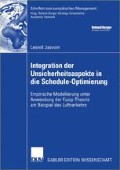Access this chapter
Tax calculation will be finalised at checkout
Purchases are for personal use only
Preview
Unable to display preview. Download preview PDF.
Literatur
Vgl.) ROMMELFANGER, H. (2002), S. 4–5
siehe ZADEH, L. A. (1965)
Vgl.) ROMMELFANGER, H. (2002), S. 8
Vgl.) KEHR, J. (1995), s. 46
Vgl.) KEHR, J. (1995), S. 49
Es existieren jedoch Vorschläge, das Supremium durch die algebraische Summe zu ersetzen, siehe ROMMELFANGER, H. (2002), S. 36
zu den Vorteilen der dreieckigen Form der Zugehörigkeitsfunktionen siehe PEDRYCZ, W. (1993)
Einen guten Überblick über die in der Literatur vorfindbaren formalen Beschreibungen der parametrischen Zugehörigkeitsfunktionen geben z.B. DOMBI, J. (1990) S. 3ff. und SMITHSON, M. (1988), S. 77ff.
Vgl.) RABETGE, C. (1991), S. 22
Vgl.) DUBOIS, D. / PRADE, H. (1986), S. 347
Vgl.) ROMMELFANGER, H. (2002), S. 53
Vgl.) KEHR, J. (1995), S. 98–100
Vgl.) RABETGE, C. (1991), S. 75
Dazu siehe z.B.: LITOIU, M. / TADEI, R. (2001), S. 41ff.; BORTOLAN, G. / DEGANI, R. (1985), S. 3ff.; LIOU, T.S. / WANG, M.JJ. (1992), S. 248ff.; FORTEMPS, P. / ROUBENS, M. (1996), S. 320ff.; ROMMELFANGER, H. (1986), S. 219ff.
Vgl.) RABETGE, C. (1991), S. 58
Vgl.) KEHR, J. (1995), S. 89
Vgl.) RABETGE, C. (1991), S. 52; MEGAGLIA, A. / SHU-CHERNG, F. / NUTTLE H. et al. (2002), S. 85
Vgl.) DUBOIS, D. / PRADE, H. (1986), S. 346
Vgl.) DUBOIS, D. / PRADE, H. / SANDRI, S. (1993), S. 110–111
Zu Methoden der Abfrage der Zugehörigkeitsgrade siehe etwa BILGIC, T. / TÜRKSEN, I. (1995); SMITHSON, M. (1987), S. 77ff.; RABETGE, C. (1991), S. 59ff; VERKUILEN, J. (2001), S. 14ff.; SPIES, M. (1993), S. 221ff; DUBOIS, D. / PRADE, H. (1989), S. 145ff; INUIGUCHI, M. / TANINO, T. / SAKAWA, M. (2000), S. 38 ff.
Vgl.) CORNELISSEN, A. / VAN DEN BERG, J. / KOOPS, W. et al. (2002), S. 13
Vgl.) RABETGE, C. (1991), S. 62
Vgl.) RABETGE, C. (1991), S. 62
Siehe z.B. DOMBI, J. (1998), ZIMMERMANN, H.-J. / ZYSNO, P. (1988)
Vgl.) DUBOIS, D. / PRADE, H. (1989), S. 137
Vgl.) RABETGE, C. (1991), S. 63
Vgl.) YAO, D. (2003); MARTI, K. (2002); BIRGE, J. R. / LOUVEAUX, F. (1997)
Vgl.) KEHR, J. (1995), S. 45
Vgl.) KEHR, J. (1995), S. 45
Vgl.) ZIMMERMANN, H.-J. (1999), S. 162
Vgl.) ZIMMERMANN, H.-J. (1999), S. 163
Vgl.) KEUPER, F. (1999), S. 129
Rights and permissions
Copyright information
© 2006 Deutscher Universitäts-Verlag ∣ GWV Fachverlage GmbH, Wiesbaden
About this chapter
Cite this chapter
(2006). Darstellung der Unsicherheitsaspekte mit Hilfe der Theorie der Fuzzy-Mengen. In: Integration der Unsicherheitsaspekte in die Schedule-Optimierung. DUV. https://doi.org/10.1007/3-8350-5709-X_5
Download citation
DOI: https://doi.org/10.1007/3-8350-5709-X_5
Publisher Name: DUV
Print ISBN: 978-3-8350-0324-8
Online ISBN: 978-3-8350-5709-8
eBook Packages: Business and Economics (German Language)

